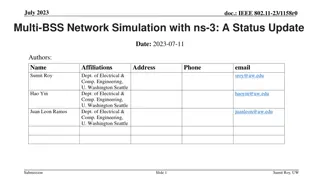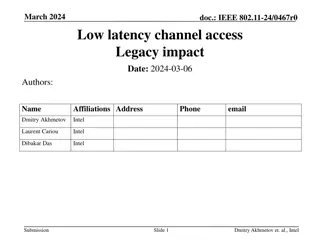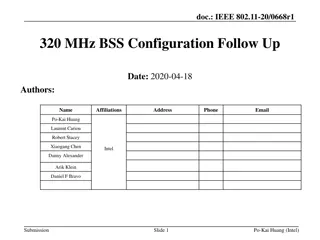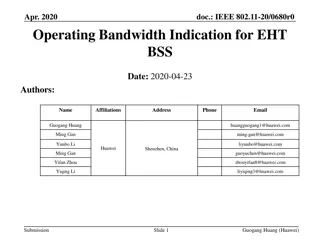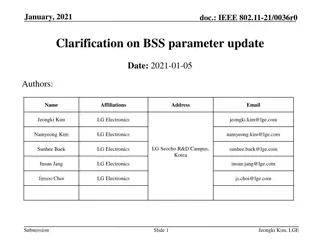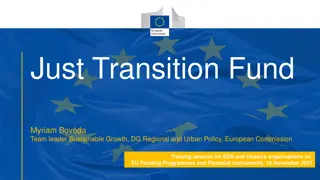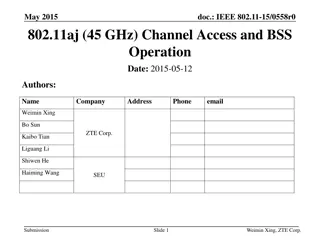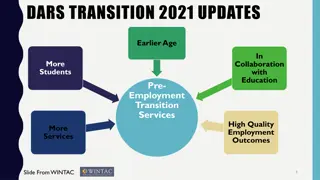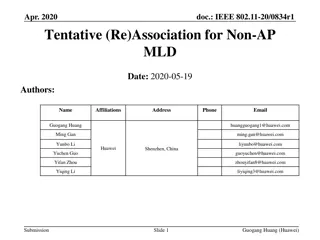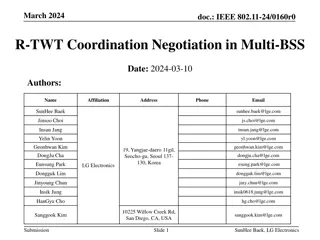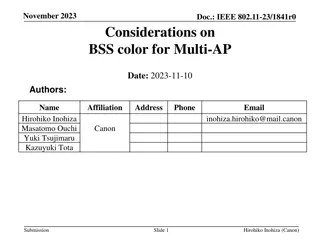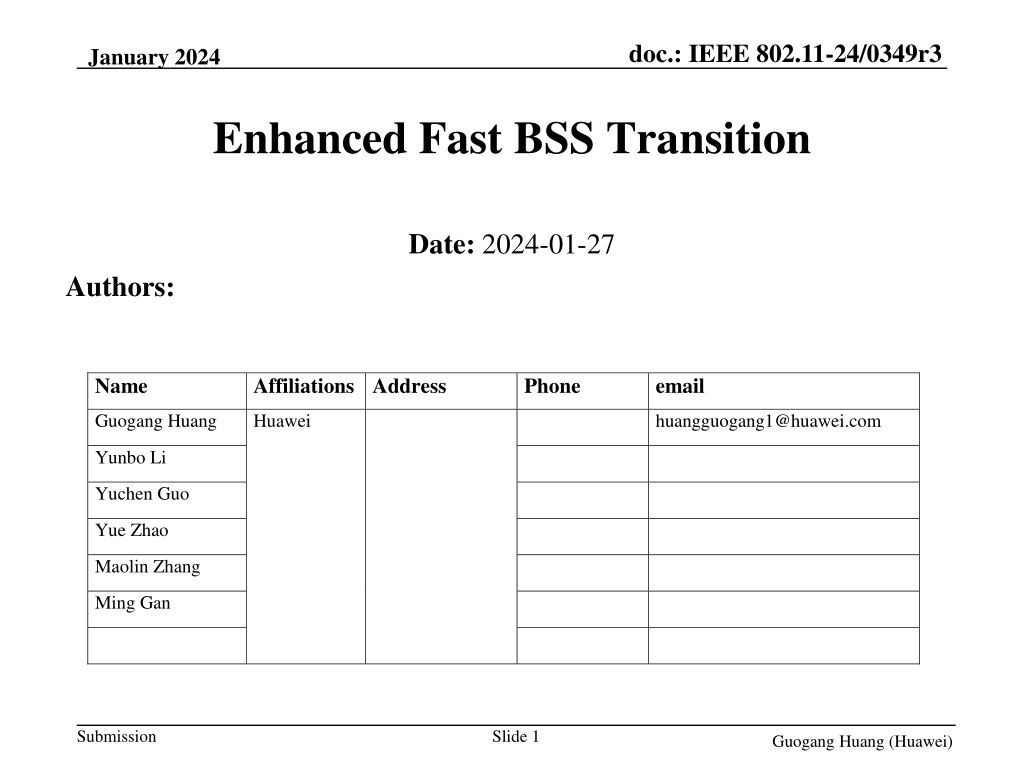
Enhanced Fast BSS Transition for Improved Roaming Performance
"Explore enhancements to the Fast BSS Transition protocol for better roaming performance between Access Points (AP) by enabling context transfer and data continuity. Discuss improvements and comparisons with existing methods."
Download Presentation

Please find below an Image/Link to download the presentation.
The content on the website is provided AS IS for your information and personal use only. It may not be sold, licensed, or shared on other websites without obtaining consent from the author. Download presentation by click this link. If you encounter any issues during the download, it is possible that the publisher has removed the file from their server.
E N D
Presentation Transcript
doc.: IEEE 802.11-24/0349r3 January 2024 Enhanced Fast BSS Transition Date: 2024-01-27 Authors: Name Affiliations Address Phone email Guogang Huang Huawei huangguogang1@huawei.com Yunbo Li Yuchen Guo Yue Zhao Maolin Zhang Ming Gan Submission Slide 1 Guogang Huang (Huawei)
doc.: IEEE 802.11-24/0349r3 January 2024 Introduction Several contributions [1-2] has discussed the context transfer to enable the data continuity when a non-AP MLD is roamed from the current AP MLD to the target AP MLD. The fast BSS transition (FT) protocol is a widely implemented roaming protocol, which relies on the concept of Make before break . We also think the FT protocol should be improved by enabling the context transfer to improve the roaming performance between AP MLDs, including between roaming AP MLDs. In this contribution, we will discuss candidate improvements for the current FT protocol and provide the comparison between the proposed enhanced FT and the roaming AP MLD method with the context transfer. Submission Slide 2 Guogang Huang (Huawei)
doc.: IEEE 802.11-24/0349r3 January 2024 Recap Fast BSS transition [3] Make before break Upon a successful reassociation, the PTKSA has been established and proven live. The SME of the AP shall open the IEEE 802.1X Controlled Port. The FTO shall transition to State 4 (as defined authentication and association)). If the target AP is distinct from the previous AP, the FTO shall enter State 1 with respect to the previous AP. Upon a successful reassociation, the FTO shall delete any corresponding PTKSA with its previous AP. The SME of the FTO shall issue an MLME-DELETEKEYS.request primitive to delete the pairwise keys with the previous AP, and the FTO and the AP shall issue an MLME-SETKEYS.request primitive and MLMESETPROTECTION.request primitive to install the pairwise keys. Before successful reassociation with the target AP MLD, the non-AP MLD still can exchange data with the current AP. in 11.3 (STA Submission Slide 3 Guogang Huang (Huawei)
doc.: IEEE 802.11-24/0349r3 January 2024 Summary of candidate improvements Improvement 1. Enable the context transfer (excluding the PTKSA context) and the data forwarding to avoid the packet loss resulting from flushing the Tx/Rx buffer Achieve zero packet loss Improvement 2. Enable the over-the-DS probing nearby APs which can avoid the transmission rate drop resulting from the off- channel scanning This is very beneficial to the EMLSR non-AP MLD which only has one link for the data Tx/Rx. Submission Slide 4 Guogang Huang (Huawei)
doc.: IEEE 802.11-24/0349r3 January 2024 Enhanced FT procedure Specifically, define FT Probe Request/Response frames The non-AP MLD exchanges FT Probe Request/Response frames with the current AP MLD to get info on nearby AP MLDs Thus the non-AP MLD doesn t need to switch the channel to probe nearby APs. And define Context Transfer Request/Response to enable the context transfer. Non-AP MLD Current AP MLD Target AP MLD DS DS FT Probe Request FT Probe Response Target AP MLD Current AP MLD FT Request AP 1 AP 2 AP 1 AP 2 FT Response Reassociation Request The non-AP MLD monitors RSSIs received current AP MLD and target AP MLD respectively and select a propriate roaming point. Context Transfer Request from Context Transfer Response Reassociation Response STA 2 STA 1 DS-STA-NOTIFY.Request (MOVE) Non-AP MLD Submission Slide 5 Guogang Huang (Huawei)
doc.: IEEE 802.11-24/0349r3 January 2024 Discussions (1/3) Based on the above enhanced FT procedure, we can see the above Reassociation Request/Response frames can achieve multiple functions which is very time-consuming, e.g. Multi-link setup Trigger the context transfer Unblock the IEEE 802.1X Controlled Port and invoke the reassociation service to update the DS mapping if the reassociation is successful [3] This may cause the non-AP MLD too hard to estimate the completion time of receiving the Reassociation Response frame and select a propriate roaming point. Submission Slide 6 Guogang Huang (Huawei)
doc.: IEEE 802.11-24/0349r3 January 2024 Discussions (2/3) Based on the above analysis, another possible improvement is to define new frames to respectively realize the multi-link setup and trigger the context transfer (including the reassociation service). For example Define FT Multi-link Setup Request/Response frames to realize the link setup Define Roaming Request/Response frames to invoke the reassociation service Target AP MLD Current AP MLD DS Non-AP MLD FT Probe Request FT Probe Response FT Request FT Response FT Multi-link Setup Request The non-AP MLD monitors RSSIs received from current AP MLD and target AP MLD respectively and select a propriate roaming point. FT Multi-link Setup Response Roaming Request Context Transfer Request Context Transfer Response Roaming Response DS-STA-NOTIFY.Request (MOVE) Submission Slide 7 Guogang Huang (Huawei)
doc.: IEEE 802.11-24/0349r3 January 2024 Discussions (3/3) Comparison between enhanced FT and the roaming AP MLD with the context transfer (including the PTKSA context). [1] We can see the extra negotiation of a new PTKSA will not cause the data connection interruption with the current AP MLD and degrade the roaming performance if the FT protocol is used. The proposed enhanced FT method can provide almost the same roaming performance compared with the roaming AP MLD with the context transfer. Then why would we take a risk to allow the PTKSA can be shared among AP MLDs? The only advantage of the roaming AP MLD method is the potential support of multiple serving AP MLDs. Fig. Candidate roaming procedure under roaming AP MLD Fig. Enhanced FT procedure Submission Slide 8 Guogang Huang (Huawei)
doc.: IEEE 802.11-24/0349r3 January 2024 Conclusions We have discussed candidate improvements for the FT protocol Enable the context transfer and the data forwarding Enable probing the target AP MLD over the DS via the current AP Enable the over-the-DS multi-link setup and define a new frame to invoke the reassociation service We also have compared the proposed enhanced FT method with the roaming AP MLD method with the context transfer The proposed enhanced FT method can provide almost the same roaming performance compared to the roaming AP MLD method with the context transfer So it seems even the roaming AP MLD with the context transfer (including the PTKSA) is allowed from the security point of view, it is not necessary to go this way. Submission Slide 9 Guogang Huang (Huawei)
doc.: IEEE 802.11-24/0349r3 References [1] 11-23-1996-00-00bn-improve-roaming-between-mlds [2] 11-23-1897-00-00bn-thoughts-on-improving-roaming- under-existing-architecture [3] IEEE Draft P802.11REVme_D5.0 Submission Slide 10 Guogang Huang (Huawei)
doc.: IEEE 802.11-24/0349r3 Appendix A There is any precedent to share PTK among APs or AP MLDs even for other standard organizations. Example 1. CAPWAP (Control and Provisioning of Wireless Access Points) The CAPWAP protocol supports two modes of operation: Split and Local MAC. In Split MAC mode, the MAC functionality is divided between controller and AP in the following fashion: Controller Responsibilities: Security management (policy enforcement, rogue detection, etc.); Configuration and firmware management; Non real-time 802.11 MAC functions: Association, Dis-Association, Re-Association, 802.11e/WMM Resource Reservation (CAC, TSPEC, etc.), 802.1x/EAP Authentication, Encryption Key Management. Access Point Responsibilities: Data encapsulation and de-capsulation via CAPWAP; Real-Time 802.11 MAC Functions: Beacon generation, Probe responses, Power management and packet buffering, 802.11e/WMM scheduling and queuing, MAC layer data encryption and decryption, 802.11 control messages (ACK, RTS/CTS), Fragmentation and re-assembly Submission Slide 11 Guogang Huang (Huawei)
doc.: IEEE 802.11-24/0349r3 Appendix A (Cont.) There is any precedent to share PTK among APs or AP MLDs even for other standard organizations. Example 2. DAPS (Dual Active Protocol Stack) Which allows a UE simultaneously exchange data with two source gNB and target gNB with different ciphering during the roaming period. Submission Slide 12 Guogang Huang (Huawei)
doc.: IEEE 802.11-24/0349r3 Appendix B Definition of (re)association (Re)association is one important of terms in IEEE 802.11 protocols. We have the following descriptions on (re)association in REV D5.0 [3] Association is one of the services in the DSS. For a non-GLK STA, the act of becoming associated invokes the association service, which provides the STA to AP mapping to the DS. The reassociation service is invoked to move a current association of a non-AP STA from one AP to another. In an ESS, the reassociation service informs the DS of the current mapping between AP and STA as the STA moves from BSS to BSS within the ESS. A single IEEE 802.1X Port maps to one association, and each association maps to an IEEE 802.1X Port. Each association between a pair of STAs creates a unique pair of IEEE 802.1X Ports, and authentication takes place relative to those ports alone. Only the fast BSS transition facility can move an RSNA during reassociation. Therefore, if FT is not used, the old RSNA is deleted and a new RSNA is constructed. The word (re)association should be carefully used especially when we discuss the roaming AP MLD architecture. Submission Slide 13 Guogang Huang (Huawei)
doc.: IEEE 802.11-24/0349r3 January 2024 Straw Poll 0 Do you support to improve the current fast BSS transition protocol in 11bn? Note: Some harmonization based on [24/0349r3, 24/0679r0] Yes: No: Abstain: Submission Slide 14 Guogang Huang (Huawei)
doc.: IEEE 802.11-24/0349r3 January 2024 Straw Poll 1 Do you support 11bn to define an enhanced FT protocol that when a non-AP MLD roams from one AP MLD to another AP MLD, the context related to the non-AP MLD is transferred from the one AP MLD to the other AP MLD such that it preserves the data exchange context for the non-AP MLD? Details of the context (excluding the PTKSA context) are TBD Note: Some harmonization based on [24/0349r3, 24/0679r0] Yes: No: Abstain: Submission Slide 15 Guogang Huang (Huawei)
doc.: IEEE 802.11-24/0349r3 January 2024 Straw Poll 2 Do you support to define in 11bn that a non-AP MLD probes the target AP MLD over the DS via the current AP MLD? Note: Some harmonization based on [24/0349r3, 24/0679r0] Yes: No: Abstain: Submission Slide 16 Guogang Huang (Huawei)
doc.: IEEE 802.11-24/0349r3 January 2024 Straw Poll 3 Do you support to define in 11bn that a non-AP MLD sets up one or more links with target AP MLD over the DS via the current AP MLD? Yes: No: Abstain: Submission Slide 17 Guogang Huang (Huawei)



